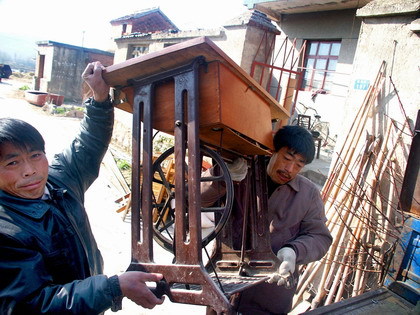Developers who obtain arable land will have to reclaim an area of equal size to get approval for building on their acquisitions, land authorities said yesterday.
|

|
|
Farmers move from houses slated for demolition to make way for a development zone in suburban Nanjing, Jiangsu province. A new rule to address the depleting land bank requires developers to reclaim areas equal to the arable land they have obtained. File photo |
The move is the latest in a slew of measures introduced to tighten the country's fast-depleting land bank.
The new requirement will be put into effect this month and targets all projects in the country except "key projects of national significance", said Huang Hetu, a deputy division director in charge of arable land protection with the Ministry of Land and Resources (MLR).
Key projects excluded from the new rule include the South to North Water Diversion Project and the high-speed railway linking Beijing and Shanghai.
Since 1998, the ministry has required developers using land already planned for usage by local governments to provide compensation in the form of land reclamation.
Developers working on projects that were not considered in land planning by local authorities, or those that were deemed "important projects", such as covering the hydraulic, military and power sectors, could first acquire the land before providing compensation.
Such exceptions have caused many problems, resulting in imbalances in the local land market and cutting the quantity of land in reserve, Huang said.
Illegal arable land acquisition has also been rampant in recent years, due to expanding urbanization and cheap rural land prices, said Li Xiaoyun from the Chinese Agriculture University.
This has resulted in a consistent decline in the country's arable land bank in recent years, which dropped to 121.73 million hectares by the end of last year from 127.6 million hectares in 2001, MLR figures have showed.
The number was just 1.73 million hectares, above the government's "critical" mark of 120 million hectares set for 2020.
The country currently has about 13.3 million hectares of reserve land, with about 40 percent of the area possessing good sunlight and irrigation conditions.
Under the new regulation, all developers can reclaim land from the local arable land reserve, or pay the local land authorities for the amount of land they should reclaim. The land being reclaimed should be reserved for farmers first, Huang said.
The move also stipulates that local governments should expand their land reserve bank by reclaiming more land or re-adjusting the existing land market.
Those regions that fail to meet their land reclamation quota will be subject to a cut in the construction land quota given by the central authorities in the following year.
"The new regulation comes at a crucial time, amid the country's fast urbanization, to ensure a stable arable land bank," Li said.
To further ensure sustainable development in the sector, the country has added more than 2.7 million hectares of arable land through required land reclamation in the past nine years. The measures have essentially compensated for land lost to construction or natural disasters, MLR figures showed.
Still, regional disparities remain, Li said.
More developed regions in the east have tended to trade for quotas of reserve land from less developed western regions. Even within the same province or city, some land compensated by developers is of inferior quality compared with the quality land they acquire.
To tackle these problems, the ministry has also banned the trading of land quotas among provinces.
"The ministry should make it clear in the following policies to ensure such lands being reclaimed are of equal quality," Li said.
(China Daily September 10, 2008)